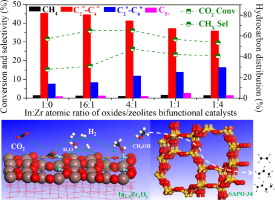Journal of Catalysis ( IF 6.5 ) Pub Date : 2018-06-23 , DOI: 10.1016/j.jcat.2018.06.010 Shanshan Dang , Peng Gao , Ziyu Liu , Xinqing Chen , Chengguang Yang , Hui Wang , Liangshu Zhong , Shenggang Li , Yuhan Sun

|
Direct production of lower olefins (C2=−C4=: ethylene, propylene and butylene), basic carbon-based building blocks, from carbon dioxide (CO2) hydrogenation is highly attractive, although the selectivity towards olefins has been too low. Here we present a series of bifunctional catalysts contained indium-zirconium composite oxides with different In:Zr atomic ratios and SAPO-34 zeolite, which can achieve a selectivity for C2=–C4= as high as 65–80% and that for C2–C4 of 96% with only about 2.5% methane among the hydrocarbon products at CO2 conversion of 15–27%. The selectivity of CO via the reverse water gas shift reaction is lower than 70%. The product distribution is completely different from that obtained via CO2-based Fischer-Tropsch synthesis and deviates greatly from the classical Anderson-Schulz-Flory distribution. The zirconium component plays a critical role in determining the physicochemical properties and catalytic performance of bifunctional catalysts. Catalyst characterization and density functional theory calculations demonstrate that the incorporation of a certain amount of zirconium can create more oxygen vacancy sites, stabilize the intermediates in CO2 hydrogenation and prevent the sintering of the active nanoparticles, thus leading to significantly enhanced catalytic activity, selectivity of hydrocarbons and stability for direct CO2 hydrogenation to lower olefins at the relatively high reaction temperature of 380 °C.
中文翻译:

锆在直接CO 2加氢生成氧化物/沸石双功能催化剂上的低级烯烃中的作用
尽管二氧化碳对烯烃的选择性太低,但从二氧化碳(CO 2)氢化直接生产低碳烯烃(C 2 = -C 4 =:乙烯,丙烯和丁烯),碱性碳基建材非常有吸引力。在这里,我们介绍了一系列双功能催化剂,其中包含In:Zr原子比不同的铟锆复合氧化物和SAPO-34沸石,它们对C 2 = –C 4 =高达65–80%的选择性具有选择性。 C 2 – C 4为96%,在CO 2的烃类产品中只有约2.5%的甲烷转化率为15–27%。通过反向水煤气变换反应的CO的选择性低于70%。产物分布与通过基于CO 2的费-托合成获得的分布完全不同,并且与经典的安德森-舒尔茨-弗洛里分布大不相同。锆组分在决定双功能催化剂的物理化学性质和催化性能方面起着至关重要的作用。催化剂表征和密度泛函理论计算表明,一定量的锆的掺入可以产生更多的氧空位,使中间体稳定在CO 2中氢化并防止活性纳米颗粒的烧结,从而导致在380°C的较高反应温度下显着增强的催化活性,碳氢化合物的选择性以及直接CO 2加氢生成低级烯烃的稳定性。











































 京公网安备 11010802027423号
京公网安备 11010802027423号